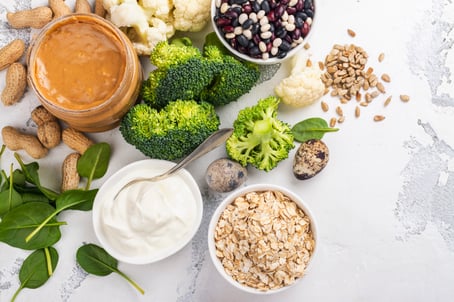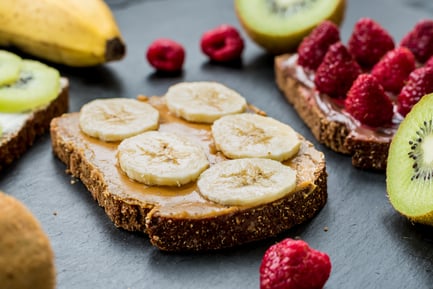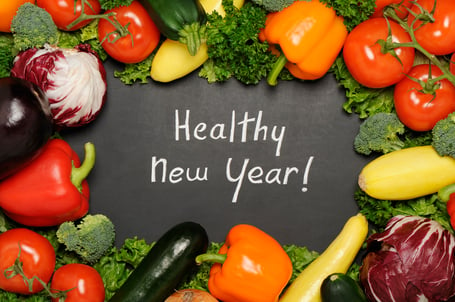 Intuitive eating is the practice of eating in response to your body’s internal hunger and fullness cues, rather than external cues, such as environmental or social triggers that prompt eating behaviors, regardless of true hunger or fullness levels. In today’s society, it is especially difficult to eat intuitively as we are near constantly being bombarded with messaging that tells us what we should or shouldn’t eat and that labels foods as “good” or “bad.” Overtime, as the mind and body become used to ignoring hunger signals, the cues begin to fade and are more and more difficult to notice or may only be noticed when the body is in an extreme, ravenous state, which is likely to lead to overeating, which is then followed by feelings of guilt and desire to restrict based on external cues and continued ignoring of internal hunger cues. For many, the body must be reconditioned, starting with reconnecting with your biological hunger cues. Here’s how to start:
Intuitive eating is the practice of eating in response to your body’s internal hunger and fullness cues, rather than external cues, such as environmental or social triggers that prompt eating behaviors, regardless of true hunger or fullness levels. In today’s society, it is especially difficult to eat intuitively as we are near constantly being bombarded with messaging that tells us what we should or shouldn’t eat and that labels foods as “good” or “bad.” Overtime, as the mind and body become used to ignoring hunger signals, the cues begin to fade and are more and more difficult to notice or may only be noticed when the body is in an extreme, ravenous state, which is likely to lead to overeating, which is then followed by feelings of guilt and desire to restrict based on external cues and continued ignoring of internal hunger cues. For many, the body must be reconditioned, starting with reconnecting with your biological hunger cues. Here’s how to start:
1. Start paying attention to how your body signifies hunger.
The most common and well-known symptoms of hunger include stomach grumbling or growing/gurgling noises; however, hunger may also present as feelings of fatigue or irritability, lightheadedness, and occasionally, with prolonged hunger, even nausea.
2. Before each meal/snack - rank your hunger/fullness on a scale of 0-10. Consider why you are eating - is it for internal reasons or external?
0: Primal hunger - intense and very urgent, may be painful
1: Anxious to eat, ravenous and irritable
2: Very hungry, looking forward to a hearty meal or snack
3: Ready to eat, but no urgency; “polite” hunger
4: Subtle hunger, slightly empty feeling in the stomach
5: Neutral - neither hungry nor full
6: Emerging fullness
7: Comfortably full - satisfied and content
8: Full - not pleasant, but not unpleasant
9: Very full/too full (as if you need to unbutton pants or remove belt)
10: Uncomfortably, even painfully full. May feel nauseated.
3. Aim to eat a balanced meal or snack (protein + fiber + healthy fat) when hunger level is below a 5.
If you are feeling hungry, consider what foods will be most nourishing and what you may have lacked in previous meals (typically fiber or protein).
If you still have the desire to eat despite being >6 on the hunger scale, you may be mistaking true hunger for a different type of hunger, such as emotional hunger, or desire to eat to cope with uncomfortable feelings, or taste hunger, or a desire to eat based on taste or because a food sounds good. It’s OK to eat for taste or comfort on occasion, but for many, due to the years of prolonged suppression of natural hunger cues, practicing portion control in these settings becomes difficult, and overeating often occurs. In these instances, consider other ways to cope with boredom or stimulate the senses that don’t involve food, such as taking a walk, reading a book, calling a friend, lighting a candle, or putting on lotion.
If you’re still struggling with the concept of intuitive eating, how to implement it, or how to identify true, physiological hunger vs emotional or taste hunger, consider reaching out to a dietician for support!

 Back-to-school season is a great time for a fresh start - whether you’re a student, parent, or both! However, as your schedule changes and so does the season, there are many obstacles to getting or staying on track when it comes to your nutrition, exercise and other health-related goals. From having to wake up earlier to help the kids get ready for school to having to stay up late to complete school assignments, many factors can disrupt your usual eating, sleeping, or exercising routines. To stay ahead of these disruptions, the best strategy is to have a plan. Begin thinking about how the change to your schedule may require you to adjust your eating or exercise routines. Does the start of the school year mean you will have to get up earlier to get your workout in before you see the kids off to school? Will a late-night class or evening sports practice interfere with your usual dinner routine? If so, what adjustments need to be made to help you stay on track?
Back-to-school season is a great time for a fresh start - whether you’re a student, parent, or both! However, as your schedule changes and so does the season, there are many obstacles to getting or staying on track when it comes to your nutrition, exercise and other health-related goals. From having to wake up earlier to help the kids get ready for school to having to stay up late to complete school assignments, many factors can disrupt your usual eating, sleeping, or exercising routines. To stay ahead of these disruptions, the best strategy is to have a plan. Begin thinking about how the change to your schedule may require you to adjust your eating or exercise routines. Does the start of the school year mean you will have to get up earlier to get your workout in before you see the kids off to school? Will a late-night class or evening sports practice interfere with your usual dinner routine? If so, what adjustments need to be made to help you stay on track? imilarly to your eating routine, consider what changes must be made to maintain your exercise goals or if your exercise goals need to be reevaluated. Ask yourself: when can I realistically fit exercise/activity into my new routine/schedule? Do I need to make adjustments to the frequency or length of my activities? Are there other ways I can be active if my schedule doesn’t allow for structured exercise? For example - park the car further away from the store/office, take 5 minute breaks periodically between assignments or work tasks to get some
imilarly to your eating routine, consider what changes must be made to maintain your exercise goals or if your exercise goals need to be reevaluated. Ask yourself: when can I realistically fit exercise/activity into my new routine/schedule? Do I need to make adjustments to the frequency or length of my activities? Are there other ways I can be active if my schedule doesn’t allow for structured exercise? For example - park the car further away from the store/office, take 5 minute breaks periodically between assignments or work tasks to get some 
 In today’s busy world, it’s easy to put self-care on the back burner. When there are seemingly endless deadlines at work that must be met, household chores to tackle, and a calendar that is jam-packed it can be extremely difficult to even think about taking time out for ourselves. This is why we must take just a few minutes out of our days. And, as Millennial as it may sound, we need to begin to give some love to ourselves so that we not only exist, but live life to the fullest.
In today’s busy world, it’s easy to put self-care on the back burner. When there are seemingly endless deadlines at work that must be met, household chores to tackle, and a calendar that is jam-packed it can be extremely difficult to even think about taking time out for ourselves. This is why we must take just a few minutes out of our days. And, as Millennial as it may sound, we need to begin to give some love to ourselves so that we not only exist, but live life to the fullest.
 As many of us are confronted with the decision of whether to send our children back to school or continue with online learning, we are faced with many questions that we had never had to ask ourselves before. Breakfast, lunch, and often snacks are mainly consumed during these hours at school, so as we continue to see Indiana trying to return to normal and reopen, we might need to tailor our eating habits to ensure we are not risking unnecessary exposure to COVID-19 when refueling our bodies throughout the day. These ideas also work for adults who are returning to the workplace or have already returned to the workplace.
As many of us are confronted with the decision of whether to send our children back to school or continue with online learning, we are faced with many questions that we had never had to ask ourselves before. Breakfast, lunch, and often snacks are mainly consumed during these hours at school, so as we continue to see Indiana trying to return to normal and reopen, we might need to tailor our eating habits to ensure we are not risking unnecessary exposure to COVID-19 when refueling our bodies throughout the day. These ideas also work for adults who are returning to the workplace or have already returned to the workplace. A few years ago, I made it my New Year’s Resolution to completely cut out animal products from my diet. I had played around with a couple variations of diets for a few years in college while competing in a Division 1 rowing program—cutting out all red meat, processed meats, and chicken, and only eating fish. Essentially the only things left were the eggs, milk, and cheese. I had been hesitant because cheese was my absolute favorite thing to add to every meal. I dreamed about doing a cheese and wine tour of Europe one day—I was really in love with cheese.
A few years ago, I made it my New Year’s Resolution to completely cut out animal products from my diet. I had played around with a couple variations of diets for a few years in college while competing in a Division 1 rowing program—cutting out all red meat, processed meats, and chicken, and only eating fish. Essentially the only things left were the eggs, milk, and cheese. I had been hesitant because cheese was my absolute favorite thing to add to every meal. I dreamed about doing a cheese and wine tour of Europe one day—I was really in love with cheese. Take these next few weeks or so and use them to your advantage. We know this is an extremely challenging time, and we want to make sure you feel like you are taken care of. Circumstances are tricky right now, so even if you adopt one new technique, consider that a win! Don’t expect yourself to “eat the rainbow” every day, feel like you fall asleep easily at night from a relaxing day working at home in your pajamas, or get in a 10-mile run each morning. While you shelter at home and stay healthy, keep these tips in mind.
Take these next few weeks or so and use them to your advantage. We know this is an extremely challenging time, and we want to make sure you feel like you are taken care of. Circumstances are tricky right now, so even if you adopt one new technique, consider that a win! Don’t expect yourself to “eat the rainbow” every day, feel like you fall asleep easily at night from a relaxing day working at home in your pajamas, or get in a 10-mile run each morning. While you shelter at home and stay healthy, keep these tips in mind. During cold and flu season, we try to do all we can to prevent illness or speed up how fast we recover from illness. One such strategy many employ is the use of Vitamin C for a natural remedy. Several products are marketed as immune system boosters because they contain large amounts of Vitamin C. Do these products really work? We set out to investigate!
During cold and flu season, we try to do all we can to prevent illness or speed up how fast we recover from illness. One such strategy many employ is the use of Vitamin C for a natural remedy. Several products are marketed as immune system boosters because they contain large amounts of Vitamin C. Do these products really work? We set out to investigate! Mondays can be hard enough, getting back into the swing of things after a much-too-short weekend. The last thought on your mind is what to cook for dinner, right? You might go out to eat instead, pick up carryout, or eat a frozen pizza for the most painless dinner prep possible. However, what if you opt for something that is not only easy for you, but also healthy for you and the planet?
Mondays can be hard enough, getting back into the swing of things after a much-too-short weekend. The last thought on your mind is what to cook for dinner, right? You might go out to eat instead, pick up carryout, or eat a frozen pizza for the most painless dinner prep possible. However, what if you opt for something that is not only easy for you, but also healthy for you and the planet? Do you feel like you get stuck in a rut eating the same things from week to week? On one hand it makes life a lot easier, right? You don’t have to scour through recipes, find that one illusive ingredient on the top shelf in the last aisle you looked in, or put the effort into prepping a meal that claims “30-minute prep” but in fact took you two hours. I completely understand!
Do you feel like you get stuck in a rut eating the same things from week to week? On one hand it makes life a lot easier, right? You don’t have to scour through recipes, find that one illusive ingredient on the top shelf in the last aisle you looked in, or put the effort into prepping a meal that claims “30-minute prep” but in fact took you two hours. I completely understand! How many of us are guilty of making a New Year’s resolution and then struggling to stick to it by the time February rolls around? Even with the best of intentions, most of us have trouble maintaining the changes that start off so strong on January 1st. Often these promises to ourselves are centered around our overall health and well-being.
How many of us are guilty of making a New Year’s resolution and then struggling to stick to it by the time February rolls around? Even with the best of intentions, most of us have trouble maintaining the changes that start off so strong on January 1st. Often these promises to ourselves are centered around our overall health and well-being.